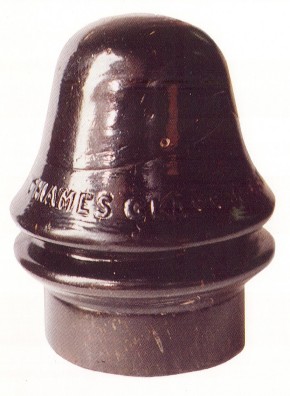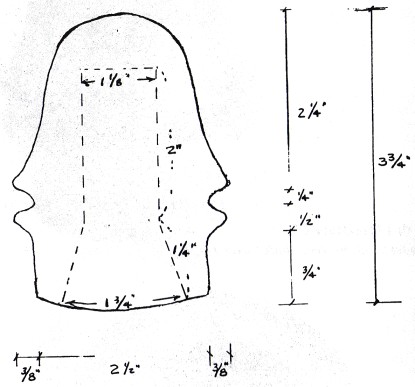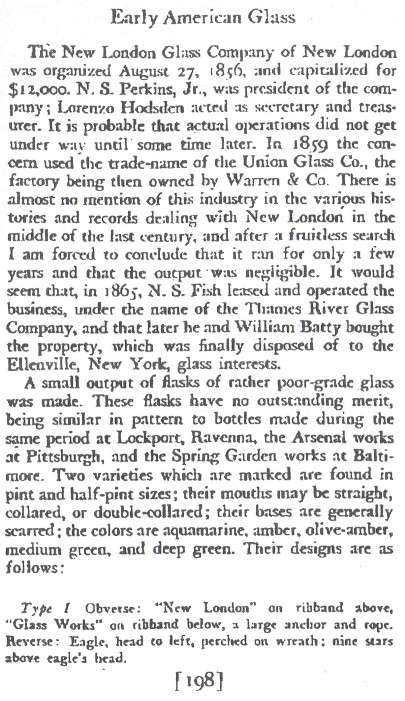Thames Glass Works Insulator -- REVISITED!!
by Kevin Lawless & Doug MacGillvary
Reprinted from "Crown Jewels of the Wire", February 1998, page 4
In 1975, the Skinner's Auction House, in Bolton, Massachusetts, sold at
auction one of the most celebrated collections of bottles in that hobby's
history - the Charlie Gardner collection! The late Mr. Gardner was a pioneer
collector of historic bottles and, as a resident of Connecticut, amassed some
impressive products from that state. Among the items sold was a specimen of a
threadless insulator, CD unknown due to the fact that the entire skirt was
missing! (See Insulators, A History and Guide to North American Glass Pintype
Insulators, McDougald, pages 13-14.) This much is certain - the insulator was
most impressive, even in its condition; it was embossed "THAMES GLASS
WORKS" on the front dome and "NEW LONDON CT" on the rear dome.
The color was black glass.

(cover photo)
THAMES GLASS WORKS embossed along front upper wire ridge.
The insulator raised quite a few eyebrows in the insulator collecting
community at the time, but was sold to an unknown party - who, it appears, was
not an insulator buff and who also has disappeared. In 1995, in preparation for
gathering New England insulators for the New England Room exhibit at the
Marlborough, MA National Show, Kevin spent an inordinate amount of time with
Skinner's Auctions attempting to locate the past and/or present owner - to no
avail.

NEW LONDON CT
embossed along rear upper wire ridge.

An interesting bird's eye view looking down at the dome of the
insulator
showing the embossing beginning at "6 o'clock" and
moving around the
upper wire ridge counter clockwise.
Not much more thought was had about the THAMES GLASS WORKS insulator until
early October, 1997 - when ANOTHER example surfaced! This one is virtually mint
and, as can be seen, plainly identifies it as a modification of CD 718 - perhaps
a new design. It is black glass (some tiny bubbles exhibit yellow olive amber,
so perhaps the true color will be described as blackglass yellow olive amber)
and has exceptional embossing.

Dimensional sketch of Thames Glass Works insulator.
Very little is known of the THAMES GLASS WORKS (pronounced "THAIMZ").
The book Early American Glass, (D 1927, by Rhea Mansfield Knittle, includes one
page (page 198) on the works and its predecessor and successor companies. The
facts have disputed some of Mrs. Knittle's statements: The original name was NEW LONDON GLASS COMPANY; then UNION GLASS COMPANY; then THAMES GLASS WORKS
(not THAMES RIVER GLASS COMPANY); and, finally, FORT TRUMBULL GLASS COMPANY. It
is believed that the demise of FORT TRUMBULL GLASS COMPANY (after New York City
interests bought and moved it to, apparently, Ellenville, New York) may have
been in the late 1860's. In fact, there may have been more companies than those
listed having done business at this site, but more historical research will be
needed.

Large Image (283 Kb)

Large Image (303 Kb)
Location of the Thames Glass Works, New London, CT, c. 1865
All of these companies operated at a glass house in New London, Connecticut
located in the block bordered by Goshen Street on the west, Trumbull Street on
the south, Smith Street on the east and Walbach Street on the north. The section
of Goshen Street no longer exists and the entire site is now part of the city of
New London's waste water treatment plant, so, unfortunately, there will be no
excavations looking for relics.
This is a tremendous discovery for our hobby - as well as for Connecticut
glass historians - and we will be happy to update the hobby as more information
unfolds.
| 